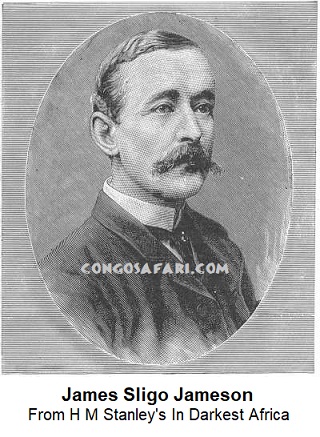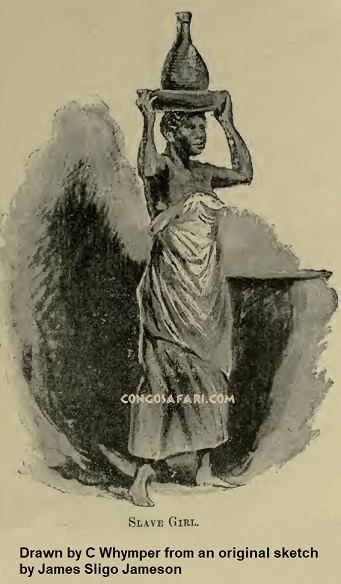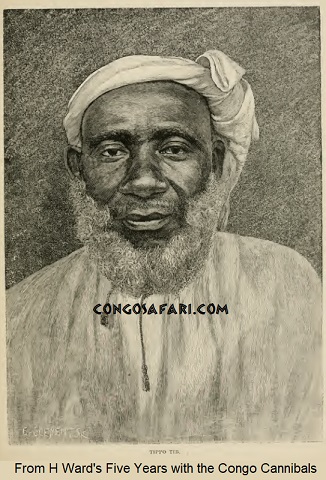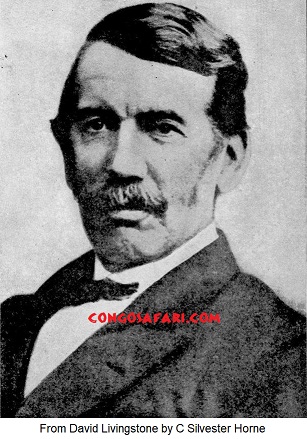James Sligo Jameson and the "Wacusu Cannibals"
Jameson the Fool and Livingstone the Ghoul
© D J Trotter, September 2019
AbstractH M Stanley's deputy James Sligo Jameson, by his own account, deliberately paid to see proof that the Bakusu (Wacusu) were cannibals, and watched as a little girl was stabbed to death, following which Bakusu tribesmen dismembered her. Jameson even made sketches of the incident. However, the incident proved only that slaves can be made to kill and dismember people, and probably eat them. It did not prove that cannibalism was part of Bakusu culture. Jameson was vilified but he claimed that he thought it a joke until it was too late. He may have had the excuse of being a fool but Dr David Livingstone tried to do what Jameson did, with no excuse and with cold, scientific deliberation. If Jameson was a fool, Livingstone was a ghoul. IntroductionThe Bakusu (Wacusu) Child Murder, Butchery and Cannibalism Conclusion References IntroductionBakusu slaves undoubtably killed and dismembered a child to "prove" that they were cannibals. Assad Farran accused James Sligo Jameson of deliberately buying the child in order to witness her being eaten. Tippu Tip, allegedly at least as guilty as Jameson, denied any knowledge of the incident. Jameson called Farran's accusation a "tissue of falsehoods" but was his version of events significantly different? Does Tippu Tip's denial hold water? Jameson was demonised in the English press, yet David Livingstone tried to do the same as he did. Should Livingstone not also have been vilified? Most importantly, did the incident prove that cannibalism was part of Bakusu culture? The Bakusu (Wacusu)The Bakusu (aka Wacusu, Kusu, Wakusu, Kutsu, Wakutsu or Kongola, etc.) live mostly in what is now Maniema province of the Democratic Republic of the Congo. According to H M Stanley, their country, called Ukusu, is open, with palm trees, and on the left (presumably west) bank of the Lualaba River[1]. They are noted for their fine woodcarving[2]. The prefix Ba- is commonly used in Bantu languages to indicate specific or ethnic groups of people. The prefix Wa- is the Swahili equivalent. Stanley used both Bakusu and Wakusu to refer to the people of Ukusu[1], and James Sligo Jameson called them Wacusu[3]. According to Sir Harry Johnston, the Bakusu are an extension of the Manyema: "The Manyema, still occupying the region north of the Luama River, have extended under the name of Bakusu across to the Lomami, ..."[4] Of the "Manyema (Bakusu)", Johnston wrote that they ate even the corpses of people who died of disease, and left the bodies in running water until almost putrid, and ate the meat raw[4]. Stanley called the Bakusu "belligerent and cannibalistic"[1]. However, those accusations may have been unjust. For one thing, by Stanley's admission, they were on the defensive: "The Arabs, each time they have attempted to penetrate Ukusu, have been repulsed with slaughter."[1] Like the Manyema, the Bakusu suffered slavery more than other tribes of the eastern Congo. According to Jameson, this was because of less desirable natives being "too much disfigured by tattooing, slit ears and lips, etc."[3] Child Murder, Butchery and Cannibalism
James Sligo Jameson, the Irish whiskey heir who, for a time, commanded Stanley's Rear Column during the rescue of Emin Pasha, probably did witness an event related to real cannibalism. It took place in the town of Riba-Riba (now called Lokandu[5]) on the Lualaba River, on May 11th 1888. Jameson's interpreter, Assad Farran, in an affidavit to Belgian authorities in the Congo Free State, claimed that in order to witness cannibalism, and on the advice of Tippu Tip, Jameson knowingly bought a little slave girl, who was taken to a group of cannibals. The cannibals were told that the child was a gift from a white man who wanted to watch while she was being eaten. The girl was then tied to a tree, after which she was disembowelled and dismembered while Jameson made sketches[6]. By Jameson's own account, Assad Farran was with him on the journey to Riba-Riba, and although Jameson's diary entry for May 11th does not mention Farran, Jameson never denied that he was present. Jameson was unlikely to have been far from his interpreter, as although on May 2nd he wrote "I am beginning to understand a good deal of Swahili now, especially if the person gesticulates and acts", that could not have been adequate for important conversations with Tippu Tip and his lieutenants. In a letter reproduced in his posthumously published book, Jameson called Farran's accusations "one tissue of falsehoods" but his own version of the events is almost equally damning[3]. While they watched Bakusu dancers, Tippu Tip regaled Jameson with stories of Bakusu cannibalism. The article on Wikisource, at the time of my writing, states that Jameson gave the dancers six handkerchiefs, which they interpreted as a "challenge" to prove their cannibalism[7]. That is incorrect and, frankly, whitewashes Jameson's culpability. Jameson himself wrote that after he implied that Tippu Tip's cannibalism stories were lies, Tippu said something to an associate called Ali. Ali then said that if Jameson provided a "bit of cloth", he would see proof that Tippu Tip was telling the truth. Jameson sent a servant to bring six handkerchiefs, and Ali made the arrangements. So, Jameson admitted that the handkerchiefs were handed to Ali for the express purpose of seeing proof of cannibalism. After some time, "a man appeared, leading a young girl of about ten years old by the hand ...". The man stabbed the child twice and "she fell on her face, turning over on her side." Then three Kusu slaves "ran forward, and began to cut up the body of the girl ; finally her head was cut off, and not a particle remained, each man taking his piece away down to the river to wash it."
So, contrary to the Wikisource article, the handkerchiefs were not given as a reward to the Bakusu dancers, but as payment to someone who owned a slave girl. Also, Jameson did not write that the three Kusu slaves who dismembered the child included any of the dancers he had watched earlier. Jameson implied that he did not watch while the girl was being eaten, but I cannot doubt that it would have been arranged if he had insisted upon it. As to Assad Farran's claim that the cannibals were told that the little girl was a present from a white man who wanted to watch her being eaten, Jameson, if he was telling the truth, could not have been in a position to confirm or deny it. As to Farran's claim that Jameson sketched the murder while it happened, it seems unlikely, even if he had wanted to. As Jameson wrote just four days later, on May 15th 1888, "One great drawback to art in this country is the fact that all the natives and a great many of the Arabs believe that they will certainly die if you make a picture of them, and so one loses many sketches." Jameson admitted that he sketched the incident while it was still fresh in his mind. Whether those sketches still exist I do not know but mercifully, perhaps, they did not appear in his book. If they are ever found, they could, e.g., prove or disprove Assad Farran's claim, contrary to Jameson's account, that the little girl was tied to a tree before being stabbed. Jameson's colleague, the renowned sculptor Herbert Ward, wrote about a meeting with John Rose Troup that "He further told me that Jameson had had a very interesting and successful trip to Kassongo, and made some very good sketches, some of which had been prepared after a cannibal feast at which he had been present."[8] Unfortunately, Troup did not mention those sketches in his book, With Stanley's Rear Column[9]. Tippu Tip, when he learned that H M Stanley had published Assad Farran's accusation that he and Jameson had been involved in the murder, butchery and eating of a little girl, denied everything: "The story is a lie. I was not there, but neither saw nor heard anything of it till to-day among you. That he — Jameson — could do such a thing is absolutely impossible. Or do you think that I would tolerate such a thing?"[10]
Clearly, he was not yet aware that Jameson had also accused him. However, the fact that both Jameson and HIS accuser, Assad Farran, stated that Tippu Tip was involved, makes me certain that Tippu was not telling the truth. Besides, he was in Riba-Riba at the time of the murder, so it is not possible that he would not have been quickly told about the incident, even in the unlikely event of both Jameson and Farran lying about his presence during the killing. An article in The Spectator of January 10th, 1891, based purely on Jameson's own account of what happened, stated that "Jameson stands convicted out of his own mouth of having quietly looked on at a crime so black and hideous that every English-man shudders now at the very mention of his name."[11] Jameson claimed that until the last moment, he thought that it was all a joke or "a ruse to get money out of me". A feeble excuse that may have been but he may have been a fool. David Livingstone was certainly no fool, and he was not joking when he wrote "I offered a large reward in vain to any one who would call me to witness a cannibal feast."[12] Surely, an intelligent man such as Livingstone must have realised that by offering such a reward, he risked causing someone to be murdered and eaten on his behalf. The fact that unlike Jameson, he was not taken up on his offer does not to any degree reduce his culpability. Moreover, Jameson implied that he neither saw, nor wanted to see, anyone being eaten, but that is precisely what Livingstone wanted to see. If Jameson was at best a fool, Doctor Livingstone was at best a scientific ghoul.
Livingstone was undoubtably a devout Christian and a very brave man. He was also a scientist: physician, explorer and geographer. During his career, the scientist eclipsed the missionary and on this occasion, arguably, eclipsed his humanity. Yet Jameson was vilified and the Reverend Doctor Livingstone was still revered. Perhaps Livingstone displayed the level of his hubris (and of his racism?) when on May 21st 1872, he wrote, when he correctly realised that he might not be exploring the source of the Nile, "... I am oppressed with the apprehension that after all it may turn out that I have been following the Congo; and who would risk being put into a cannibal pot, and converted into black man for it?"[13] Even proving the source of the mighty Congo was beneath the great Doctor Livingstone. ConclusionBoth James Sligo Jameson and Assad Farran agreed that Jameson paid to see proof that the Bakusu (Wacusu) were cannibals, and that it resulted in the murder and butchery of a little girl in Jameson's presence. Both Jameson and Farran claimed that Tippu Tip at least partly instigated the incident. Tippu denied any knowledge of it but since he was in Riba-Riba at the time, it is not plausible that he could have been unaware of it until long afterwards, even in the unlikely event that both Farran and Jameson lied about his presence during the actual killing and dismemberment. Whether additional details of Farran's accusation were correct is hardly relevant, as they would only determine whether Jameson was a monster or just an idiot. However, Doctor David Livingstone offered a large reward to be allowed to watch a cannibal feast, and any reasonable man would have realised that someone could have been murdered so that the reward could be claimed. Jameson was rightly vilified for his role in the murder of a child. Yet simply because in Livingstone's case, nobody was willing to commit murder even for a large reward, he continues to be revered in many quarters. If James Sligo Jameson was a fool, Dr David Livingstone was a ghoul. The incident in Riba-Riba (now Lokandu) has been regarded as proof of Bakusu cannibalism. However, although it proved that dreadful masters can make slaves do dreadful things, it did not prove that cannibalism was part of Bakusu culture. References
|
COPYRIGHT text © D J Trotter, September 2019 : No material on this site may be copied by any means, without the author's permission.




